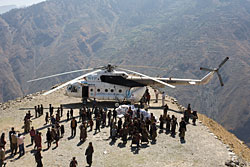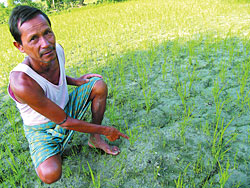 HUNGER MAP OF NEPAL |
 WFP GRAIN DRAIN: A United Nations helicopter drops off sacks of rice at a school playground in remote Humla after the failure of winter rains this year. |
An apocalyptic new report by the UN's World Food Programme (WFP) warns of a "sharp and sustained decline" in food production in Nepal. Even if only some of WFP's predictions come true, food shortages could trigger widespread social unrest.
'The Cost of Coping: A Collision of Crises' adds up the cost of the global fuel, food and economic crises and how these are magnified by a stagnation in Nepal's food production, growing population and political instability. In addition, a cycle of droughts and floods has pushed an already vulnerable population to the edge of famine.
As a result, 3.4 million Nepalis don't have enough to eat. An additional five million Nepalis have fallen below the poverty line in the past three years: forcing them to take children out of school, east seed stock or sell land.
'If current production growth rates remain constant?it is likely that within the next 3-5 years Nepal will become food deficit at a national level even during years of normal harvest,' warns the report.
There are more mouths to feed, but Nepal's rice production actually fell by one percent between 2002-2007, while harvests increased by 16 percent in Bangladesh and 31 percent in India. Nepal's investment in agriculture fell from 30 percent of the budget to 5 percent in 2008, and even so only 16.5 percent of the allocated money was spent.
"The three aspects of food security: production, availability and affordability, and we have to respond to each," says Yubaraj Khatiwada, the newly-appointed head of the National Planning Comission.
The winter drought in 2006-7 was followed by another eight-month drought last winter and then a bad monsoon this summer. This may lead to a food grain deficit of more than 200,000 tons because winter harvests in the mountains came down by half and even the Tarai may suffer huge rice harvest shortfalls this summer.
But at the Ministry of Agriculture and Cooperatives (MoAC), spokesman Hari Dahal says the WFP report is "alarmist". He admits the food deficit has affected 700,000 people, and adds: "I haven't heard anyone dying of hunger. there is no shortage."
 |
Sixty percent of children under five in the mountains are undernourished: one of the worst figures in the world. Nepal is now even more unlikely to achieve the UN's goal of eradicating extreme poverty and hunger by 2015.
The government needs more effective distribution of subsidised grain to hotspots, expansion of food for work programs like the ones implemented by WFP, and school meals for vulnerable children.
The WFP report concludes with this dire warning: 'If urgent action is not taken to address Nepal's food crisis, then the situation will deterioirate further through this decade and the next?urgent prioritisation of national food security is required at the highest level of the Nepal government and supporting development partners.'
SUPER RICE
 KUNDA DIXIT |
For a country so dependent on rainfed agriculture as Nepal, there is a tried and tested way to make rice less water-intensive. The real surprise is why the government isn't promoting it more vigorously.
The rice seeds are not a high-yield hybrid, nor genetically modified. It doesn't need farmers to flood their fields, nor use chemical fertilisers and pesticides. The secret lies in a method of cultivation called SRI (System of Rice Intensification).
In trials in Morang and Nawalparasi, the new method of rice cultivation has yielded double the harvests for only one-third of the seedling and with very little water. The only drawback is that farmers have to spend more time weeding their fields.
Ananta Ram Majhi (pictured), a farmer near Biratnagar, used to harvest five tons per hectare, and has been getting double that amount after he adopted SRI seven years ago.
"Initially, I thought to myself, if this is such a great idea why didn't my ancestors think of it?" he told Nepali Times.
Actually, farmers have been more enthusiastic than agronomists and government officials in Kathmandu. SRI was invented by a French Jesuit in Madagascar in 1983 and has since been adopted in 20 countries from Cuba to China.
Indian scientists at the Punjab Agricultural University and in north-east India have been conducting limited trials for SRI in arid areas, but are encouraged enough by results to extend it to other areas. This year's failed monsoon has renewed interest in India for SRI.
The success of the technique depends on skillful farming, good timing, weeding and careful planting and drainage. SRI converts in Nepal include agronomist Rajendra Uprety who initiated the SRI trials in Morang in 2002. He is convinced no part of Nepal need be short of food if SRI is promoted nationally.
READ ALSO:
The miracle is it's no miracle', FROM ISSUE #256 (15 JULY 2005 - 21 JULY 2005)
Early warning - FROM ISSUE #463 (07 AUG 2009 - 13 AUG 2009)
Confusion in the time of cholera - FROM ISSUE #463 (07 AUG 2009 - 13 AUG 2009)
"Disaster in the making" - FROM ISSUE #463 (07 AUG 2009 - 13 AUG 2009)


